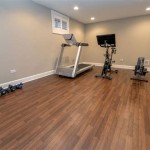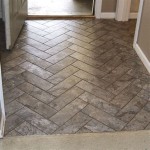White Oak Peel and Stick Flooring: A Comprehensive Guide
White oak peel and stick flooring presents a viable and increasingly popular option for homeowners and renters seeking an affordable and relatively simple flooring solution. This flooring type emulates the aesthetic of traditional white oak hardwood while offering the convenience of easy installation and removal. Understanding the composition, benefits, limitations, and installation procedures associated with white oak peel and stick flooring is crucial for making an informed decision regarding its suitability for specific applications.
This article provides a detailed overview of white oak peel and stick flooring, covering its construction, advantages, disadvantages, installation process, maintenance requirements, and factors to consider when choosing the right product. The objective is to offer a comprehensive resource for individuals exploring this flooring option.
Peel and stick flooring, in general, consists of a layered construction. The top layer is typically a wear layer, designed to resist scratches, scuffs, and stains. This layer is often made of a transparent vinyl or polyurethane material. Beneath the wear layer is a decorative layer, which in the case of white oak peel and stick flooring, is a printed image replicating the appearance of white oak wood. This layer provides the visual appeal, including the grain patterns, knots, and color variations characteristic of natural white oak. The core layer provides stability and thickness to the flooring tile or plank. Finally, the bottom layer is coated with an adhesive that allows the flooring to be directly adhered to a subfloor. This adhesive is covered with a protective backing that is peeled away prior to installation.
White oak, as a natural hardwood, is prized for its durability, beauty, and versatility. The peel and stick versions aim to capture this sought-after aesthetic in a more readily available and cost-effective format. The quality of the printed decorative layer significantly impacts the overall appearance and realism of the flooring. Higher quality prints offer greater detail and variation, resulting in a more authentic wood look. The wear layer's thickness and composition dictate the flooring's resistance to wear and tear, directly affecting its longevity.
Understanding the Advantages of White Oak Peel and Stick Flooring
White oak peel and stick flooring offers several advantages that contribute to its growing popularity. These advantages primarily relate to cost, ease of installation, maintenance, and aesthetic versatility.
One of the most significant advantages is its cost-effectiveness. Compared to traditional hardwood flooring, white oak peel and stick options are significantly less expensive. This lower price point makes it an accessible option for budget-conscious homeowners or renters looking to upgrade their flooring without a substantial financial investment. The reduced cost extends beyond the material itself. Installation costs are also minimized, as professional installation is often unnecessary due to the simplified, DIY-friendly installation process.
Installation is undoubtedly a key benefit. The peel and stick mechanism eliminates the need for nails, screws, or adhesives, simplifying the process considerably. The tiles or planks are simply peeled and adhered to a clean, level subfloor. This ease of installation makes it a popular choice for DIY projects, saving time and money on professional labor. The ease of installation also makes it a suitable option for temporary flooring solutions, such as in rental properties where permanent modifications may be restricted. Moreover, mistakes are relatively easy to rectify, allowing for adjustments during the installation process.
Maintenance is another area where white oak peel and stick flooring excels. The wear layer provides a protective barrier against stains, spills, and scratches, making it relatively easy to clean and maintain. Regular sweeping or vacuuming is typically sufficient to remove dirt and debris. For more stubborn stains, a damp mop with a mild cleaning solution can be used. The water-resistant properties of vinyl further contribute to its ease of maintenance, making it suitable for areas prone to moisture, such as kitchens and bathrooms (although full water submersion should still be avoided).
From an aesthetic perspective, white oak peel and stick flooring offers a versatile design option. The realistic wood-look visuals allow homeowners to achieve the desired appearance of white oak flooring without the expense and challenges associated with natural hardwood. The availability of various shades, grain patterns, and plank sizes provides flexibility in design choices, allowing for customization to match different interior styles. It complements both modern and traditional interiors, adding a touch of warmth and sophistication to any room.
Addressing the Limitations of White Oak Peel and Stick Flooring
While white oak peel and stick flooring offers many advantages, it is crucial to acknowledge its limitations to make an informed decision. These limitations primarily concern durability, longevity, subfloor requirements, and overall feel compared to traditional hardwood.
Durability is a key consideration. While the wear layer provides some protection, white oak peel and stick flooring is generally less durable than traditional hardwood or even engineered hardwood. It is more susceptible to scratches, dents, and tears, particularly in high-traffic areas or homes with pets. The lifespan of peel and stick flooring is typically shorter than that of more robust flooring options. While it can last for several years with proper care, it may eventually require replacement, particularly in areas with heavy use. The level of durability is directly correlated to the thickness and quality of the wear layer; thicker wear layers offer better protection but also increase the cost.
Subfloor preparation is critical for the success of any peel and stick flooring installation. The subfloor must be perfectly clean, smooth, and level. Any imperfections, such as bumps, cracks, or debris, will telegraph through the flooring, affecting its appearance and potentially compromising its adhesion. Uneven subfloors can also lead to premature wear and tear. This often necessitates extensive subfloor preparation, including patching, leveling, and cleaning, which can add to the overall project cost and time. Failure to properly prepare the subfloor can result in bubbling, lifting, and eventual failure of the adhesive bond.
The feel and sound of peel and stick flooring are different from those of traditional hardwood. Vinyl flooring can feel colder and less substantial underfoot than natural wood. It also tends to be more susceptible to temperature fluctuations, potentially expanding and contracting, which can lead to gaps or buckling. The sound of footsteps on vinyl flooring can also be different, often producing a hollow or echoey sound compared to the solid sound of hardwood. While advancements in technology have improved the feel and sound of vinyl flooring, it still lacks the natural warmth and acoustics of real wood.
Key Considerations for Choosing and Installing White Oak Peel and Stick Flooring
Selecting the right white oak peel and stick flooring and ensuring proper installation are essential for maximizing its benefits and minimizing potential issues. Several factors should be considered during the selection process, including wear layer thickness, adhesive quality, aesthetic appeal, and subfloor compatibility. Careful attention to detail during installation is equally critical for achieving a professional and long-lasting result.
The wear layer thickness is a primary factor to consider. A thicker wear layer provides greater protection against scratches, scuffs, and stains, extending the flooring's lifespan. For high-traffic areas or homes with pets, it is advisable to choose a product with a thicker wear layer. The wear layer thickness is typically measured in mils (thousandths of an inch). Residential applications generally require a wear layer of at least 6 mils, while commercial applications may require 12 mils or more.
Adhesive quality is crucial for ensuring a secure and long-lasting bond between the flooring and the subfloor. A strong adhesive is essential to prevent lifting, bubbling, and shifting of the tiles or planks. Look for products with a reputable adhesive that is specifically designed for vinyl flooring. Some adhesives are formulated for specific subfloor types, such as concrete or wood, so it is essential to choose the appropriate adhesive for the intended application. The adhesive should also be resistant to moisture and temperature fluctuations to maintain its bond over time.
Aesthetic considerations play a significant role in the selection process. Choose a white oak peel and stick flooring that complements the overall design style of the room. Consider the color, grain pattern, and plank size. Lighter shades of white oak can create a bright and airy feel, while darker shades can add warmth and sophistication. Wider planks can create a more modern and spacious look, while narrower planks can evoke a more traditional feel. It is advisable to obtain samples of different products to compare their appearance in the actual room setting.
Subfloor preparation is a vital step in the installation process. Before installing the flooring, thoroughly clean the subfloor to remove any dirt, dust, debris, or existing adhesives. Repair any cracks, holes, or imperfections with a suitable patching compound. Level any uneven areas with a self-leveling compound. Ensure that the subfloor is completely dry before proceeding with the installation. A moisture meter can be used to verify the moisture content of the subfloor. Failure to properly prepare the subfloor can lead to adhesion problems and premature failure of the flooring.
The installation process should follow the manufacturer's instructions carefully. Allow the flooring to acclimate to the room temperature for at least 48 hours before installation. This will help to prevent expansion and contraction issues. Start by laying out the flooring in the desired pattern to plan the layout and minimize waste. Use a sharp utility knife to cut the tiles or planks to fit around corners and edges. Peel off the backing and carefully position the flooring onto the subfloor, pressing firmly to ensure a secure bond. Use a roller to smooth out any air bubbles and ensure uniform adhesion. Leave a small expansion gap around the perimeter of the room to allow for expansion and contraction.

Trafficmaster Take Home Sample Natural White Oak Peel And Stick Water Resistant Luxury Vinyl Plank Flooring Br 505423

Trafficmaster Take Home Sample Natural White Oak Peel And Stick Water Resistant Luxury Vinyl Plank Flooring Br 505423

Achim Nexus 6 X36 1 2mm Peel Stick Vinyl Floor Planks 10 15 Sq Ft White Oak

Achim Sterling 1 2 White Oak 6 In X 36 Peel And Stick Vinyl Plank Flooring 15 Sq Ft Case Stp1 2wo10 The Home

Achim Sterling White Oak 6x36 1 2mm Self Adhesive Vinyl Floor Planks 10 15 Sq Ft

Achim Sterling White Oak 0 07 Mil X 6 In W 36 L Peel And Stick Vinyl Plank Flooring 15 Sq Ft Carton Stp1 2wo10 At Lowes Com

Achim Sterling White Oak 0 07 Mil X 6 In W 36 L Peel And Stick Vinyl Plank Flooring 15 Sq Ft Carton Stp1 2wo10 At Lowes Com

Style Selections 6 In X 36 Greige White Oak Peel And Stick Vinyl Planks 24 Box 1100 880535 20 Rona

30 48cm X Rustic Oak Peel And Stick Vinyl Floor Tiles Etsy

Rift White Oak Wood Veneer 24 X 48 With Peel And Stick Adhesive Psa Backer 3m Etsy








